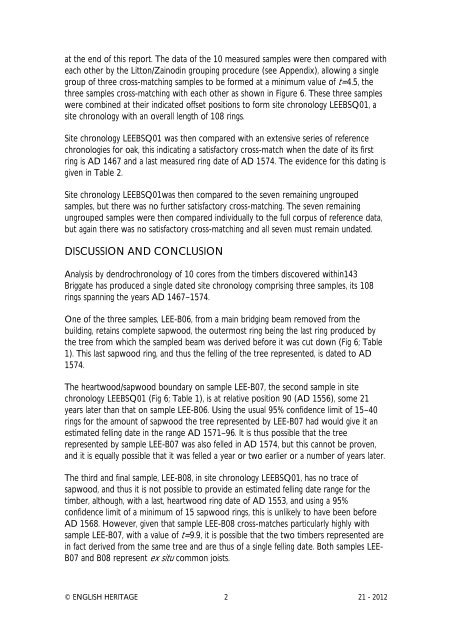Untitled - English Heritage
Untitled - English Heritage
Untitled - English Heritage
Create successful ePaper yourself
Turn your PDF publications into a flip-book with our unique Google optimized e-Paper software.
at the end of this report. The data of the 10 measured samples were then compared with<br />
each other by the Litton/Zainodin grouping procedure (see Appendix), allowing a single<br />
group of three cross-matching samples to be formed at a minimum value of t=4.5, the<br />
three samples cross-matching with each other as shown in Figure 6. These three samples<br />
were combined at their indicated offset positions to form site chronology LEEBSQ01, a<br />
site chronology with an overall length of 108 rings.<br />
Site chronology LEEBSQ01 was then compared with an extensive series of reference<br />
chronologies for oak, this indicating a satisfactory cross-match when the date of its first<br />
ring is AD 1467 and a last measured ring date of AD 1574. The evidence for this dating is<br />
given in Table 2.<br />
Site chronology LEEBSQ01was then compared to the seven remaining ungrouped<br />
samples, but there was no further satisfactory cross-matching. The seven remaining<br />
ungrouped samples were then compared individually to the full corpus of reference data,<br />
but again there was no satisfactory cross-matching and all seven must remain undated.<br />
DISCUSSION AND CONCLUSION<br />
Analysis by dendrochronology of 10 cores from the timbers discovered within143<br />
Briggate has produced a single dated site chronology comprising three samples, its 108<br />
rings spanning the years AD 1467–1574.<br />
One of the three samples, LEE-B06, from a main bridging beam removed from the<br />
building, retains complete sapwood, the outermost ring being the last ring produced by<br />
the tree from which the sampled beam was derived before it was cut down (Fig 6; Table<br />
1). This last sapwood ring, and thus the felling of the tree represented, is dated to AD<br />
1574.<br />
The heartwood/sapwood boundary on sample LEE-B07, the second sample in site<br />
chronology LEEBSQ01 (Fig 6; Table 1), is at relative position 90 (AD 1556), some 21<br />
years later than that on sample LEE-B06. Using the usual 95% confidence limit of 15–40<br />
rings for the amount of sapwood the tree represented by LEE-B07 had would give it an<br />
estimated felling date in the range AD 1571–96. It is thus possible that the tree<br />
represented by sample LEE-B07 was also felled in AD 1574, but this cannot be proven,<br />
and it is equally possible that it was felled a year or two earlier or a number of years later.<br />
The third and final sample, LEE-B08, in site chronology LEEBSQ01, has no trace of<br />
sapwood, and thus it is not possible to provide an estimated felling date range for the<br />
timber, although, with a last, heartwood ring date of AD 1553, and using a 95%<br />
confidence limit of a minimum of 15 sapwood rings, this is unlikely to have been before<br />
AD 1568. However, given that sample LEE-B08 cross-matches particularly highly with<br />
sample LEE-B07, with a value of t=9.9, it is possible that the two timbers represented are<br />
in fact derived from the same tree and are thus of a single felling date. Both samples LEE-<br />
B07 and B08 represent ex situ common joists.<br />
© ENGLISH HERITAGE 2 21 - 2012

















